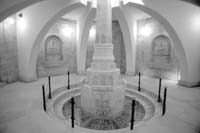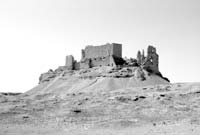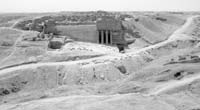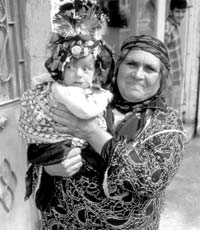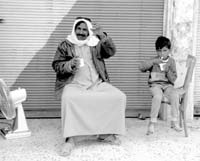Deir ez-Zor & its Armenian Genocide Memorial
By Ed Kinney, following the Euphrates River in Syria. See the May ’07 article.
It is difficult for me to imagine Deir ez-Zor being anything but a friendly, laid-back town. When my wife, Moreen, and I visited there in 1997, locals waved and children followed us saying “Hallo,” and we’d reply likewise: “Mehaba.” But now Deir ez-Zor has become an oil boom town, as Syria is attempting to increase this area’s light crude oil production. The town may be changing, but I doubt if the adjacent Euphrates River can be transformed from its flow from Turkey through Syria into Iraq.
For the past 5,500 years or so, kingdoms attempted but failed to rule this river route as it passed through ancient and, now, modern Mesopotamia. History continues to repeat itself.
Ancient sites
Leaving Deir ez-Zor, our tour took us southeast on Syria’s M5 desert highway paralleling the Euphrates toward the Iraqi border to study three more ancient ruins. The first we visited was Qal’at Rabah, a 5-sided, 12th-century-A.D. Arab citadel built during the reign of Nur al-Din to extend his control of Syria. It was later abandoned after several Mongol raids left it severely damaged, especially its interior. The best photographs of Qal’at Rabah would be distant images of the citadel on its mound.
Our second stop was Dura Europos (Salihiyah), which some historians credit as the greatest border fortress built during the Graeco-Roman period. The importance of Dura Europos was further enhanced as it was also a caravan stop and a strategic river port, which added economic strength.
Today, little remains above its foundation level, though much of its art has been reconstructed at the National Museum of Damascus. Visitors come to Dura Europos to see its commanding location on the Euphrates and its considerable size.
To understand both, I paid a local guide 100 Syrian pounds ($2) to let me sit behind him on his motorcycle for a 20-minute tour of the site. This adventure on an old, smoking motorcycle certainly improved my memory of its ruins.
Generals of Alexander the Great built Dura Europos in about A.D. 300 after conquering this area. This fortress later flourished under Rome before being destroyed by Sassanians in A.D. 256. It then lay unnoticed until 1920, when a British detachment discovered it and used it for protection against Arabs.
The last site we visited before returning to Deir ez-Zor was Mari (Tell Hariri), located only a few miles from the Iraqi border. Only its age, more than 5,000 years, and not its mud-brick ruins make this site interesting. Similar to many innocent discoveries, a Bedouin in 1933 found a 4,000-year-old statue of the sun god Shamash here. This opened the door for architectural attention but not necessarily for that of layman tourists.
Armenian Genocide Memorial
In addition to its friendly people, I vividly remember Deir ez-Zor’s Armenian Genocide Memorial, though there is no mention of it in my Syrian guidebooks. There are, however, articles on the Web describing it and why it is located there.
Modern Deir ez-Zor was built by the Ottoman Empire in 1867. It was in 1915, during the Armenian Genocide, that this town became the grim final destination for thousands of Armenians at the end of forced death marches from Anatolia, etc., to this relocation center. Most died here or in the surrounding Mesopotamia desert.
After the fall of the Ottoman Empire in 1918, France established a local garrison in Deir ez-Zor before this area became part of an independent Syria in 1946. This moving memorial to these victims was completed in 1990.
During our visit, the local Armenian priest discussed this genocide and described the memorial’s interior circular glass display of genocide victim remains rising into a white marble tower. Lebanese and Syrians make pilgrimages to this memorial organized by the Apostolic Church of Aleppo.
A wonderful way to end any visit of Deir ez-Zor is to stand at sunset on the town’s French-built footbridge (1924) over the Euphrates and reflect on how this river affected and continues to affect life in the Middle East.
Minutiae
• For tourist information re Syria, visit www.syriatourism.org. The Syrian Embassy in the U.S. is at 2215 Wyoming Ave. NW, Washington, D.C. 20008; phone 202/232-6313 or visit www.syrianembassy.us.
• Online, view data re the Armenian Orthodox Church’s genocide memorial in Deir ez-Zor at www.armenian-genocide.org.
• Based upon an Internet search, the Fourat Cham Palace Hotel remains the best. I rated it three-plus stars when we were there. Current listed prices are $135 single and $160 double with breakfast plus 11% government tax.
• We visited Deir ez-Zor with a company that retired following 9/11.
• Though there is no current travel warnings for Syria, readers should always be observant when visiting some of the areas discussed in this column.
Coming up: let’s visit the beautiful town of Amasya in the Hittite heartland of Turkey.

